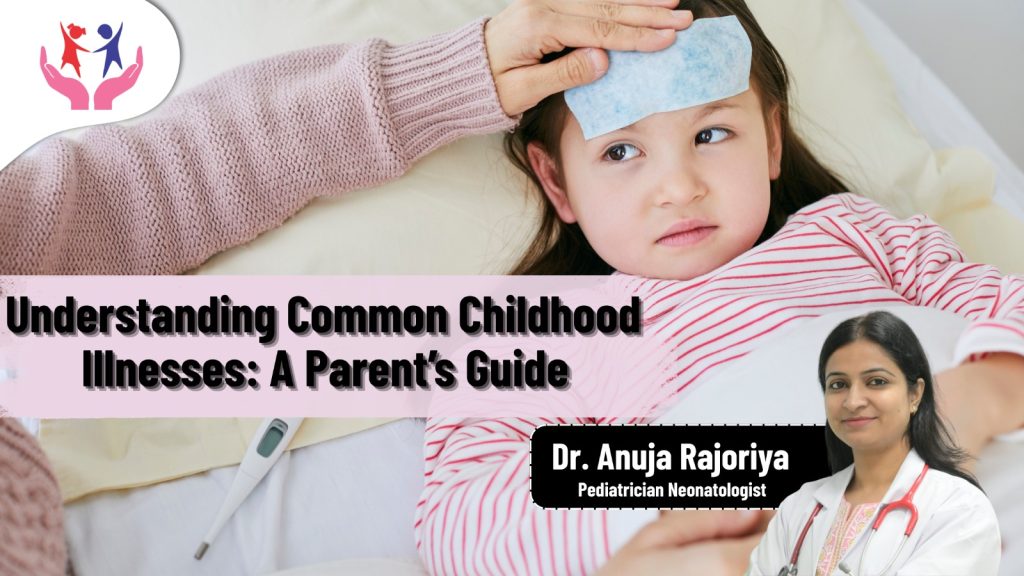
As parents, one of our greatest responsibilities is ensuring the health and well-being of our children. Childhood illnesses are an inevitable part of growing up, and understanding these conditions can help you recognize symptoms, seek appropriate care, and provide comfort to your little ones. This guide covers some of the most common childhood illnesses, their symptoms, causes, and tips for prevention and management.
1. Common Cold
Overview
The common cold is one of the most frequent illnesses affecting children, especially in the first few years of life. It is caused by various viruses, including rhinoviruses, and is highly contagious.
Symptoms
- Runny or stuffy nose
- Sore throat
- Cough
- Sneezing
- Mild headache
- Fatigue
- Low-grade fever
Causes
Colds are spread through respiratory droplets when an infected person coughs or sneezes. Children can also contract colds by touching contaminated surfaces and then touching their faces.
Management
Most colds resolve within a week. Here are some tips for managing symptoms:
- Ensure your child gets plenty of rest.
- Encourage fluid intake to stay hydrated.
- Use saline nasal drops or a humidifier to relieve nasal congestion.
- Over-the-counter pain relievers, such as acetaminophen or ibuprofen, can help alleviate headaches and fever (consult your pediatrician for proper dosages).
Prevention
- Encourage regular handwashing with soap and water.
- Teach your child to cover their mouth and nose with a tissue or elbow when coughing or sneezing.
- Avoid close contact with sick individuals.
2. Ear Infections
Overview
Ear infections are common among children, especially those under the age of three. They can occur when bacteria or viruses infect the middle ear, often following a cold.
Symptoms
- Ear pain or discomfort
- Difficulty sleeping
- Irritability or fussiness
- Fluid drainage from the ear
- Hearing difficulties
Causes
Ear infections often occur due to fluid buildup behind the eardrum, which can result from colds, allergies, or sinus infections. Young children are more susceptible because their Eustachian tubes are shorter and more horizontal.
Management
- Pain relief can be provided with over-the-counter medications, but consult your pediatrician for recommendations.
- Warm compresses applied to the ear may help soothe discomfort.
- In some cases, antibiotics may be necessary, especially if the infection is severe or recurrent.
Prevention
- Encourage your child to stay up to date with vaccinations, including the pneumococcal vaccine.
- Avoid exposing your child to secondhand smoke, which can increase the risk of ear infections.
- Teach your child to avoid drinking while lying down to prevent fluid buildup in the ears.
3. Stomach Flu (Gastroenteritis)
Overview
Gastroenteritis, commonly known as the stomach flu, is an inflammation of the stomach and intestines caused by viral or bacterial infections. It is highly contagious and can spread quickly among children.
Symptoms
- Diarrhea
- Vomiting
- Abdominal cramps
- Nausea
- Fever
- Fatigue
Causes
Stomach flu is typically caused by viruses such as norovirus or rotavirus. Bacterial infections, often from contaminated food or water, can also lead to gastroenteritis.
Management
- Ensure your child stays hydrated, especially if they are vomiting or experiencing diarrhea. Oral rehydration solutions can be beneficial.
- Avoid solid foods until vomiting subsides, then gradually reintroduce bland foods like toast, rice, or bananas.
- Monitor for signs of dehydration, such as dry mouth, reduced urine output, or lethargy, and seek medical attention if these occur.
Prevention
- Encourage regular handwashing, especially before meals and after using the bathroom.
- Teach your child not to share utensils or cups with others.
- Ensure proper food handling and hygiene at home.
4. Chickenpox
Overview
Chickenpox is a highly contagious viral infection characterized by an itchy rash and flu-like symptoms. It is caused by the varicella-zoster virus and can occur at any age, but is most common in children.
Symptoms
- Itchy rash that progresses from red spots to fluid-filled blisters
- Fever
- Fatigue
- Loss of appetite
- Headache
Causes
Chickenpox spreads through direct contact with an infected person’s rash or through respiratory droplets when an infected person coughs or sneezes.
Management
- Calamine lotion or antihistamines can help relieve itching.
- Keep your child’s nails trimmed to prevent skin infections from scratching.
- Encourage your child to stay home until all blisters have crusted over to prevent spreading the virus to others.
Prevention
- The chickenpox vaccine is highly effective and recommended for children, usually given in two doses.
- Avoid close contact with infected individuals.
5. Hand, Foot, and Mouth Disease
Overview
Hand, foot, and mouth disease (HFMD) is a common viral infection among children, especially those under five. It is characterized by sores in the mouth and a rash on the hands and feet.
Symptoms
- Fever
- Sore throat
- Painful sores in the mouth
- Rash on the hands, feet, and sometimes buttocks
- Irritability
Causes
HFMD is caused by enteroviruses, most commonly coxsackievirus. It spreads through direct contact with an infected person’s bodily fluids or contaminated surfaces.
Management
- Provide plenty of fluids to keep your child hydrated.
- Pain relievers can help alleviate discomfort.
- Encourage soft foods to avoid irritation from mouth sores.
Prevention
- Encourage frequent handwashing, especially after using the bathroom and before meals.
- Disinfect toys and surfaces regularly, especially in childcare settings.
6. Allergies
Overview
Allergies are a common issue in childhood, often resulting from environmental triggers such as pollen, dust mites, pet dander, or certain foods. Allergic reactions can range from mild to severe.
Symptoms
- Sneezing
- Itchy or watery eyes
- Runny or stuffy nose
- Skin rashes or hives
- Abdominal pain or gastrointestinal symptoms (in food allergies)
Causes
Allergic reactions occur when the immune system overreacts to a typically harmless substance. Common allergens for children include milk, eggs, peanuts, tree nuts, soy, wheat, fish, and shellfish.
Management
- Identify and avoid known allergens.
- Antihistamines can help relieve symptoms, but consult your pediatrician for appropriate options.
- In severe cases, an epinephrine auto-injector may be necessary for life-threatening reactions (anaphylaxis).
Prevention
- Breastfeeding during infancy can help reduce the risk of developing allergies.
- Introduce allergenic foods at an appropriate age, as recommended by your pediatrician.
7. Asthma
Overview
Asthma is a chronic respiratory condition that affects children of all ages. It is characterized by inflammation and narrowing of the airways, leading to difficulty breathing.
Symptoms
- Wheezing
- Shortness of breath
- Coughing, especially at night or during exercise
- Chest tightness
Causes
Asthma can be triggered by allergens, respiratory infections, exercise, cold air, or exposure to smoke and pollutants. Family history may also play a role in a child’s likelihood of developing asthma.
Management
- Work with your pediatrician to develop a personalized asthma action plan.
- Use inhalers or nebulizers as prescribed, and monitor for symptoms.
- Educate your child about avoiding triggers and recognizing early signs of an asthma attack.
Prevention
- Keep the home environment clean and free from allergens.
- Avoid secondhand smoke and limit exposure to outdoor pollutants.
- Ensure your child receives regular check-ups and asthma management education.
Conclusion
Understanding common childhood illnesses is paramount for every parent. By recognizing symptoms, knowing how to manage them, and taking preventive measures, you can help ensure your child remains healthy and happy. Always consult with a pediatrician if you have concerns about your child’s health or if symptoms persist or worsen. Your proactive approach to your child’s health will not only provide comfort but also empower you to make informed decisions about their care.
